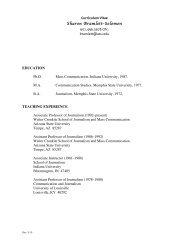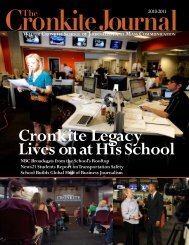New building takes shape - The Walter Cronkite School of ...
New building takes shape - The Walter Cronkite School of ...
New building takes shape - The Walter Cronkite School of ...
You also want an ePaper? Increase the reach of your titles
YUMPU automatically turns print PDFs into web optimized ePapers that Google loves.
new programs<br />
Students push<br />
the edge <strong>of</strong><br />
media research<br />
and innovation<br />
Deepak Kamalanathan, an electrical enginering graduate student, was part <strong>of</strong> the <strong>New</strong> Media Innovation Lab’s inaugural class.<br />
<strong>The</strong> <strong>New</strong> Media Innovation Lab at ASU is taking on the big<br />
questions facing the news media today:<br />
• How can news companies reach audiences, especially<br />
younger readers and viewers who have become disenfranchised<br />
from traditional media?<br />
• How can the media survive and prosper in the face <strong>of</strong> rapid<br />
technological change that is making media more fragmented, more<br />
interactive and more personal?<br />
<strong>The</strong> lab, which opened August 2006 under the direction <strong>of</strong><br />
the <strong>Cronkite</strong> <strong>School</strong>, brings together students from journalism,<br />
computer engineering, graphic design and business to work in<br />
partnership with media companies interested in the answers to<br />
those questions.<br />
In the first two semesters, students studied the news habits <strong>of</strong><br />
college-age students and developed a local music Web site,<br />
tunedig.com, that demonstrates what young people say they want<br />
on the Web.<br />
<strong>The</strong> idea for a media research and development lab came from<br />
ASU President Michael M. Crow and Sue Clark-Johnson, president<br />
<strong>of</strong> the newspaper division <strong>of</strong> Gannett Co. Inc., the nation’s largest<br />
newspaper company. Within two months <strong>of</strong> their initial discussions,<br />
the lab was up and operating in the Computing Commons.<br />
Gannett is the lab’s chief client, hiring the team <strong>of</strong> students<br />
to help the company figure out how online newspapers can best<br />
appeal to 18- to-24-year-olds. <strong>The</strong> students spent the first semester<br />
gathering and analyzing data — including conducting a survey<br />
<strong>of</strong> nearly 1,700 ASU students. <strong>The</strong>y presented their findings and<br />
recommendations to Gannett executives in December.<br />
<strong>The</strong> lab is significantly different from new media efforts at other<br />
universities, said <strong>Cronkite</strong> <strong>School</strong> Dean Christopher Callahan.<br />
“<strong>The</strong> ideas are driven by our students — some <strong>of</strong> the best and<br />
brightest — working together from many schools and departments<br />
across campus,” he said. “And our relationship with Gannett makes<br />
this a very real, focused research and development effort. Our<br />
12 2007-2008<br />
By Tara Brite<br />
students have an unparalleled experience, and they will see the<br />
tangible impact <strong>of</strong> their innovations in the new media market.”<br />
<strong>Cronkite</strong> graduate student Nicole Girard said she learned<br />
just how important social networking is to young people, while<br />
marketing senior Marlena Shirley said usability is one <strong>of</strong> the top<br />
things young people look for. If content isn’t easy to find through a<br />
search engine or from a home page, they’ll likely look elsewhere,<br />
she said.<br />
During its first year, the lab was led by Tom Mohr, an industry<br />
leader who formerly headed Knight Ridder Digital in San Jose,<br />
Calif.<br />
Mohr said media companies face great challenges trying to keep<br />
up with the rapid changes overtaking the industry. Young people<br />
now “carry devices that are literally a second brain,” he said. And<br />
they use these devices to find information in many different places.<br />
“<strong>The</strong>y’re grazers <strong>of</strong> content,” Mohr said. “<strong>The</strong>y get snippets <strong>of</strong><br />
news throughout the day.”<br />
Mohr, who spent the year traveling back and forth between the<br />
Tempe campus and his home in San Jose, said he learned as much<br />
as his students during the inaugural year <strong>of</strong> the lab.<br />
“It’s a great privilege to be involved in shaping the debate on<br />
where media should go in the world <strong>of</strong> online,” he said.<br />
Mohr returned to California this spring to head a start-up<br />
company that <strong>of</strong>fers Web services to automotive dealers and<br />
manufacturers. He was replaced by Retha Hill, former vice<br />
president for content at BET Interactive, the online unit <strong>of</strong> Black<br />
Entertainment Television. She is a digital media leader who helped<br />
launch <strong>The</strong> Washington Post’s first Internet news operation.<br />
Hill and a new team <strong>of</strong> students continued working out <strong>of</strong> the<br />
Computing Commons during the 2007-08 academic year and<br />
will move in fall 2008 to the new <strong>Cronkite</strong> <strong>building</strong> in downtown<br />
Photo by Ryan A. Ruiz





